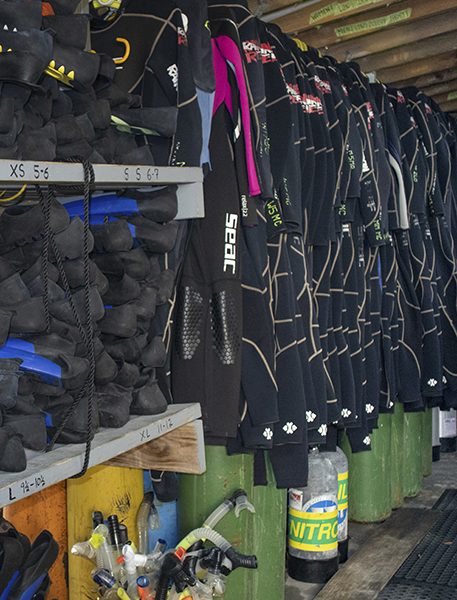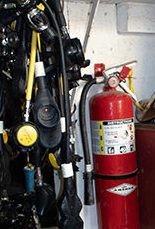CREATING A
SAFER RETAIL SHOP

RETAIL AREAS ARE DESIGNED TO be attractive to customers; they are often the first part of dive businesses that customers see. They also tend to be high-traffic areas. Compared to other areas of dive businesses, which may have obvious hazards, retail areas may be perceived as safer. While this may be true in some ways, it doesn’t mean that the retail section of a dive business is free of risk or hazards. Here are some recommendations for improving safety in areas of your business that customers frequent.
VENTILATION
AND TEMPERATURE
Providing customers with a comfortable environment to shop in is important. If you are in a tropical environment, it is important to keep your retail area cool, well-ventilated, and ideally climate controlled, which may require a powerful air conditioning system. Keeping your shop climate controlled will help preserve the integrity of your products, prevent your retail area from becoming stuffy and unpleasant for customers, and prevent mold and mildew growth, which is a major deterrent for potential customers. Mold and mildew can also present a serious health hazard to customers and staff.
CLEANLINESS
AND ORGANIZATION
Having a clean and easy-to-navigate shop is not only enticing to customers, it also makes things safer for everyone. Decluttering your dive shop can significantly reduce the risks your employees and customers face, and it eliminates hazards that can cause injuries. One of the easiest ways to eliminate tripping hazards is to ensure your retail space has clean and unobstructed walkways. To prevent people from being hit by falling objects, carefully consider what you put into overhead storage, and keep it properly secured.
One hazard that is common in dive shops is wet floors. Keeping the floor clean and dry is paramount in keeping your customers safe from nasty slips and falls. To prevent these injuries and more, consider placing nonslip mats throughout your store and installing nonslip flooring.
Maintaining a clean and organized area will not only protect staff and customers from injury, it will also show that you value cleanliness, organization, and safety.
EMERGENCY EXIT
ACCESSIBILITY
In a shop with a fully stocked retail area, there may be shelves and racks to work around. You need to ensure that it would be reasonably easy to evacuate a busy shop full of people in a timely manner in the event of an emergency. Do a walk-through of your operation and note areas that are often busy or may become congested. Could everyone make an easy exit from these areas if your shop was full and a fire broke out or a cylinder exploded? It may be necessary to do some reorganization to facilitate a quick and easy emergency evacuation. To help reduce confusion in an emergency, place clearly visible exit signs.
FIRE SAFETY
Effective fire-control procedures and firefighting equipment are essential for protecting customers, staff, and valuable inventory. The best way to protect your dive shop from fires is to prevent them from ever happening. To limit the threat to your business from fires that can’t be prevented, install fire alarms, keep fire extinguishers in key positions, and train your staff to use them. Also, be sure to conduct regular assessments of your fire extinguishers to ensure that they are in working order. According to the Occupational Safety and Health Administration (OSHA), visual inspections must be conducted on your fire extinguishers once per month and maintenance inspections once per year, so consider adding this to your maintenance schedule or emergency action plans. Proper training and functioning firefighting equipment are critical to reducing damage and saving lives in the event of a fire.
While preventative actions like cleaning up your retail area or assessing your electrical wiring as a potential ignition source may not seem like pressing considerations, it is important to do whatever you can to prevent accidents before they happen, especially when hazards can be eliminated quickly and easily. Whenever business is slow, consider using the opportunity to conduct a thorough assessment of safety considerations in your retail shop.

FIRE SAFETY
ELEMENT
Fire-safety
procedures
RISKS
Protection primarily of customers and staff, but also of valuable inventory, may depend on effective fire control procedures and equipment.
Common ignition sources for unintended fires (including electrical wiring and connections, sparks, and heated surfaces) may be present in dive shops.
An inability to escape from and to at least attempt to control a fire raises the risk to people, inventory and buildings.
RECOMMENDATIONS
Dive operators should take the following steps to prevent fires and to mitigate injuries and damage if a fire does occur:
- analyze and actively manage
all fire risks; - establish appropriate fire-
fighting procedures; - place fire extinguishers and other firefighting equipment in easily accessible locations;
- select appropriate fire-extinguishing agents based on the situation;
- ensure that fire extinguishers
are unexpired; - clearly indicate the location of fire extinguishers and exit routes;
- consider installing fire detectors, especially in areas where there is a higher risk of fire;
- enforce a no-smoking policy; and
- install appropriate, clearly visible signage to alert staff and the public to fire risks.
DAN Customer Service
Mon–Fri, 8:30 a.m. – 5 p.m. ET
+1 (919) 684-2948
+1 (800) 446-2671
Fax: +1 (919) 490-6630
24/7 Emergency Hotline
In event of a dive accident or injury, call local EMS first, then call DAN.
24/7 Emergency Hotline:
+1 (919) 684-9111
(Collect calls accepted)
DAN must arrange transportation for covered emergency medical evacuation fees to be paid.
Medical Information Line
Get answers to your nonemergency health and diving questions.
Mon–Fri, 8:30 a.m. – 5 p.m. ET
+1 (919) 684-2948, Option 4
Online: Ask A Medic
(Allow 24-48 hours for a response.)

